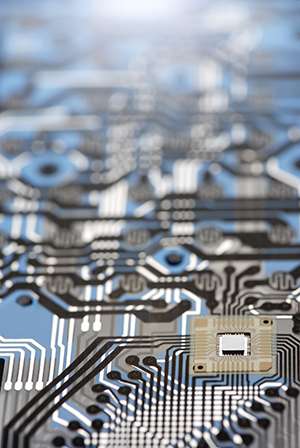Innovative electrodes allow new computer memory technologies to be compatible with existing circuitry

The computing industry faces constant demands to provide faster access to data and reduce power consumption. As current memory systems cannot meet these demands indefinitely, it is essential to develop entirely new technologies. One strong contender is resistive random access memory (RRAM), which stores binary information by switching a dielectric material between conducting and non-conducting states.
A seamless transition to this new technology requires that RRAM memory cells be compatible with existing electronics, which are usually based on complementary metal oxide semiconductors (CMOS). Now, Xin Peng Wang and co-workers at the A*STAR Institute of Microelectronics, Singapore, have designed nickel-based electrodes that can couple RRAM to CMOS systems as well as reduce the current required to switch the RRAM between memory states.
"One of the current most dominant memory systems, NAND flash, is expected to reach the limit of its scalability in 2017 or 2018," says Wang. "We need to identify emerging non-volatile memory systems with higher densities, to make up the market. Recently, RRAM has attracted lots of attention due to its fast programming and erasing speeds, high endurance and good retention of data."
Preventing neighboring RRAM cells from interfering with one another requires each cell to contain a selector made from a diode or transistor. Diode selectors have proved difficult to implement, therefore Wang and co-workers aimed to make RRAM stacks that were compatible with CMOS transistors.
To build the prototype RRAM cells, the researchers used three layers. They used physical vapor deposition to create a bottom electrode of nickel silicide or nickel germanosilicide, before adding a central dielectric switching layer of hafnium oxide, and a final top electrode of titanium nitride.
The researchers found that they could quickly and reliably switch the memory state of their cells, using very low operating currents. They suggest that the switching is enhanced by oxidation and reduction of nickel at the interfacial layer between the electrode and the dielectric. By providing more mobile oxygen species, these reactions might accelerate the formation and rupture of conductive filaments.
"Our electrodes can be easily formed on the source or drain terminal of a transistor," says Wang. "In fact, our design effectively uses a CMOS transistor source or drain directly as the bottom electrode in a RRAM cell. This can lower the total cost and improve the scalability."
In future, Wang and co-workers hope to shrink their nickel-based RRAM cells to a practical circuit scale to bring this promising technology into production.
More information: Wang, X. P., Fang, Z., Chen, Z. X., Kamath, A. R., Tang, L. J. et al. "Ni-containing electrodes for compact integration of resistive random access memory with CMOS." IEEE Electron Device Letters 34, 508–510 (2013). dx.doi.org/10.1109/LED.2013.2245627

















